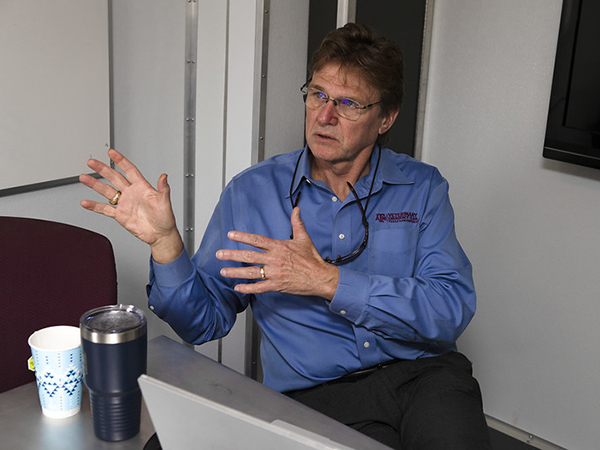Texas A&M VET Heads To Texas Panhandle For First Deployment Supporting Human Health
Story by Jennifer Gauntt, CVMBS Communications

From its first out-of-state deployment in December 2018—which was also the team’s first foray into shelter management—to its first back-to-back deployment last fall, the Texas A&M Veterinary Emergency Team has faced a lot of new challenges over the last two years.
The team is now adding to that list of firsts with a call-to-action by the Texas Division of Emergency Management (TDEM) to serve in the Texas Panhandle.
What makes this deployment unique?
It represents the first time the VET will be assisting with a public health issue primarily affecting humans, and it is also the team’s first one-man deployment.
VET director Dr. Wesley Bissett departed College Station on May 4 bound for Lubbock to serve as the operations section chief for the epidemiology unit working to trace how COVID-19 is circulating in the region.
In this role, Bissett is managing a team within the Texas Department of Health & Human Services’ (DHHS) Public Health Region 1, which serves a 41-county area in the Panhandle and South Plains.
The opportunity, Bissett said, really drives home the significance of the “One Health” paradigm—an approach that emphasizes the collaboration of entities at all levels to achieve optimal health for humans, animals, and our environment—in managing what he sees as “the One Health effort of our time.”
“The VET has worked really hard to develop expertise that is important to the state. It is very much an honor that those efforts have been recognized and that we’re asked to participate into this response,” Bissett said. “This is different than what we’ve typically done, but most of our deployments have been different in some way. It does make sense, though, as the team has both the incident management experience and the scientific background to appropriately guide response efforts.
“The VET was built for the state of Texas and the citizens of the state of Texas to do whatever job they need of us,” he said. “I’m excited about supporting the region in this way and about this new challenge as we expand the VET’s capabilities.”
Bissett was selected to serve as the operations section chief based on his leadership experience and understanding of epidemiology. Bissett earned his Ph.D. in environmental epidemiology from the Texas A&M College of Veterinary Medicine & Biomedical Sciences (CVM).
“As veterinarians, we have training that can be of assistance in a human health incident whenever the human health authorities are feeling taxed,” he said. “We have skills that are valuable to the entire system because we can pick up some of the load that human health incident would normally carry so that they can more fully focus their expertise where it’s most needed.”
The largest and most sophisticated of its kind in the country, the Texas A&M Veterinary Emergency Team (VET) provides medical support to urban search-and-rescue teams and resident animals in response to natural and manmade disasters at the request of the Texas A&M Task Force or county jurisdictions. To support the VET, click here.
###
For more information about the Texas A&M College of Veterinary Medicine & Biomedical Sciences, please visit our website at vetmed.tamu.edu or join us on Facebook, Instagram, and Twitter.
Contact Information: Jennifer Gauntt, Director of CVM Communications, Texas A&M College of Veterinary Medicine & Biomedical Sciences; jgauntt@cvm.tamu.edu; 979-862-4216


